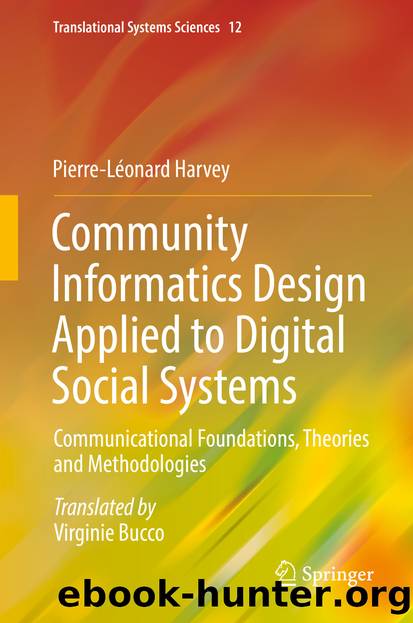Community Informatics Design Applied to Digital Social Systems by Pierre-Léonard Harvey

Author:Pierre-Léonard Harvey
Language: eng
Format: epub
Publisher: Springer International Publishing, Cham
7.5 The Community Informatics Design’s Seven Spaces: General Principles
From design works from a first course in community informatics design we have built in 2010 for the students in the master’s program in communication at the University of Bayreuth, in Germany, we present our “reference model” or the basic community informatics design architecture which is based on seven phases (or design subspaces) such as we present it in a chapter in 2014. These seven design spaces are essential to the reflection and the activities linked to the community informatics design. These reflection and action spaces seek to document the design process and its specific life cycle . This process is not dynamic or evolutive in itself, but, once fed by the members’ representation, the situation analysis, problems diagnosis and the research on partner’s needs and aspirations, it will provide a support and intervention tool for the members so they can commit to establish a responsible communication for sustainable development and strategic innovation management.
Other perspectives can be put to contribution thanks to more specific social innovation guides for the analysis of social appropriation of new technologies or other design elements from the enterprise architecture , organizational modeling and virtual communities design and also thanks to technology appropriation or strategic implantation of online animation technique guides and to user guides for the strategic management of innovation ecosystems implantation (that guides the most part of our research in the present book).
All this preliminary phase is destined to establish a first enriched image (Checkland) of the starting situation (intuitive problematic, non-initiated) that will be useful for the definition of each project’s life cycle . Life cycles are not universal, but they can look alike from one discipline or project to another. Thus, according to the state of the situation, the needs or the budget, the life cycle could be extended by a few weeks even a few months or years and will incorporate several methods, techniques, procedures and stages. In the My Portal Col@b project setting, the life cycle was a starting point to define theories , methodologies , the community informatics and communicational reference framework and the stages to overcome, in short, the detailed architecture . The task was huge but very stimulating.
The seven exploratory design spaces were mapped in the summer of 2010 (Fig. 7.6). These design spaces schematically represented an imaginary reflection territory explored, thanks to conversation and dialogue, and creativity in the action, as a possible space for concrete activities (instantiation process) being developed through “conversational design”. In Fig. 7.6 diagram, we integrate the “conversational design” theory (Jenlink 2004), Banathy’s theory (1996) and the works on activity theory from Engeström (1987, 1999) and Engeström et al. (2010). This “participative research-action ” territory is traversed by an evolutive, recursive and iterative spiral where the conversation and diverse thinking modes are articulated around different dialogue modes (exploratory, abductive, deliberative). Here is the representation of dialogue modes (according to Anthony Judge’s works on his site Laetus in Praesens) incorporated to the activity theory (Fig. 7.
Download
This site does not store any files on its server. We only index and link to content provided by other sites. Please contact the content providers to delete copyright contents if any and email us, we'll remove relevant links or contents immediately.
Algorithms of the Intelligent Web by Haralambos Marmanis;Dmitry Babenko(7852)
Hadoop in Practice by Alex Holmes(5661)
Jquery UI in Action : Master the concepts Of Jquery UI: A Step By Step Approach by ANMOL GOYAL(5514)
Life 3.0: Being Human in the Age of Artificial Intelligence by Tegmark Max(4509)
Functional Programming in JavaScript by Mantyla Dan(3723)
The Age of Surveillance Capitalism by Shoshana Zuboff(3423)
Big Data Analysis with Python by Ivan Marin(3014)
Blockchain Basics by Daniel Drescher(2891)
The Rosie Effect by Graeme Simsion(2708)
WordPress Plugin Development Cookbook by Yannick Lefebvre(2603)
Hands-On Machine Learning for Algorithmic Trading by Stefan Jansen(2519)
Applied Predictive Modeling by Max Kuhn & Kjell Johnson(2480)
Dawn of the New Everything by Jaron Lanier(2438)
Test-Driven Development with Java by Alan Mellor(2390)
The Art Of Deception by Kevin Mitnick(2299)
Data Augmentation with Python by Duc Haba(2236)
Rapid Viz: A New Method for the Rapid Visualization of Ideas by Kurt Hanks & Larry Belliston(2195)
The Infinite Retina by Robert Scoble Irena Cronin(2182)
Human Dynamics Research in Smart and Connected Communities by Shih-Lung Shaw & Daniel Sui(2178)
